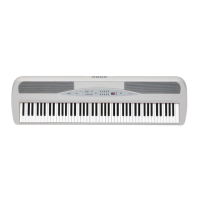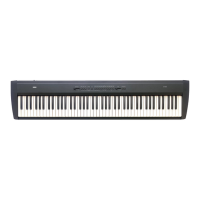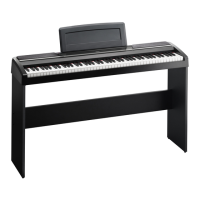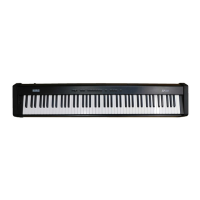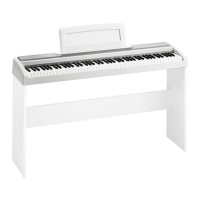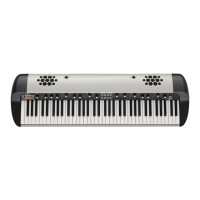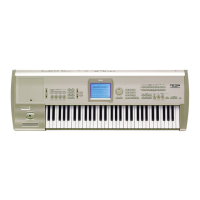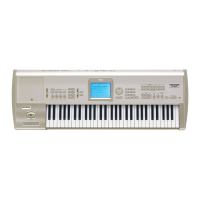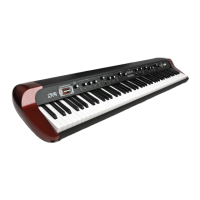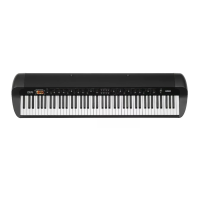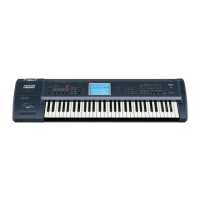Do you have a question about the Korg SP 250 and is the answer not in the manual?
Operational Precautions: Location, power, interference, handling, care, and foreign matter warnings.
Information regarding CE and FCC regulations and compliance.
Overview of key features: sounds, effects, MIDI, amplification, and headphones.
Details on Damper pedal, Metronome, Touch control, Pitch, and Temperaments.
Introduction to MIDI protocol and its uses with the SP-250.
Details on the amplifier, speakers, and headphone connections.
Identifies and describes the main controls on the front panel.
Details on Speakers, Phones, Power, Volume, Reverb, Chorus buttons.
Explains Touch, Transpose/Function, Bank, Sound, Demo, Metronome, Tempo controls.
Guides on connecting to external audio systems and using headphones.
Instructions for powering on, managing speakers, adjusting volume, and using demo songs.
Detailed instructions on playing all demo songs and selecting specific songs.
Lists demo songs and explains how to adjust demo song tempo.
Guide to selecting individual sounds from the instrument.
Instructions for layering two sounds simultaneously.
Details on selecting sounds, adjusting volumes, and using Reverb/Chorus effects.
How to set effect depths, use the damper pedal, and assign it.
Introduction and instructions for starting/stopping the metronome.
How to adjust metronome volume and enter tempo numerically.
Setting time signatures and using bell sounds for accents.
How to program and select keyboard touch sensitivity.
Functions for transposing the pitch and fine-tuning.
Choosing between Equal, Kirnberger, and Werckmeister temperaments.
Details on stretched tuning for piano sounds.
Definition of MIDI, its uses, and essential connection guidelines.
Connecting to computers and standard MIDI parameter configuration.
How to choose the MIDI channel for transmitting data.
Using the SP-250 with external MIDI devices as a 16-part tone generator.
Managing Local On/Off status and selecting sounds via MIDI Program Change.
Table mapping MIDI Program Change numbers to sounds.
Enabling/disabling MIDI Program and Control Change messages.
Saving and loading sound settings to/from MIDI devices.
Safety warnings and important notes for assembling the stand.
Step-by-step assembly instructions and list of included parts.
Steps for unfolding the stand and attaching diagonal bars.
Instructions for preparing and attaching the pedal beam to the stand.
Attaching the pedal and lifting/mounting the piano body onto the stand.
Fixing the piano, assembling the power cord, and connecting cables.
Final placement, screw checks, and warnings for transport and disassembly.
Solutions for common problems like no sound or power issues.
Explanation of polyphony limits and oscillator usage.
Detailed specifications for the KORG SP-250.
Quick access functions and diagram of keyboard controls.
Detailed chart of MIDI messages and their functions.
Information on KORG's online resources and telephone support.
Role of dealers and authorized repair services.
Information on product registration benefits and the Care-Card.
Instructions for filling out and sending the KORG-Care-Card.
Overview of services and resources available on the KORG website.
Warranty card details for France, to be returned to GAFFAREL MUSIQUE.
Address and web server details for KORG Italy SpA.
Operational Precautions: Location, power, interference, handling, care, and foreign matter warnings.
Information regarding CE and FCC regulations and compliance.
Overview of key features: sounds, effects, MIDI, amplification, and headphones.
Details on Damper pedal, Metronome, Touch control, Pitch, and Temperaments.
Introduction to MIDI protocol and its uses with the SP-250.
Details on the amplifier, speakers, and headphone connections.
Identifies and describes the main controls on the front panel.
Details on Speakers, Phones, Power, Volume, Reverb, Chorus buttons.
Explains Touch, Transpose/Function, Bank, Sound, Demo, Metronome, Tempo controls.
Guides on connecting to external audio systems and using headphones.
Instructions for powering on, managing speakers, adjusting volume, and using demo songs.
Detailed instructions on playing all demo songs and selecting specific songs.
Lists demo songs and explains how to adjust demo song tempo.
Guide to selecting individual sounds from the instrument.
Instructions for layering two sounds simultaneously.
Details on selecting sounds, adjusting volumes, and using Reverb/Chorus effects.
How to set effect depths, use the damper pedal, and assign it.
Introduction and instructions for starting/stopping the metronome.
How to adjust metronome volume and enter tempo numerically.
Setting time signatures and using bell sounds for accents.
How to program and select keyboard touch sensitivity.
Functions for transposing the pitch and fine-tuning.
Choosing between Equal, Kirnberger, and Werckmeister temperaments.
Details on stretched tuning for piano sounds.
Definition of MIDI, its uses, and essential connection guidelines.
Connecting to computers and standard MIDI parameter configuration.
How to choose the MIDI channel for transmitting data.
Using the SP-250 with external MIDI devices as a 16-part tone generator.
Managing Local On/Off status and selecting sounds via MIDI Program Change.
Table mapping MIDI Program Change numbers to sounds.
Enabling/disabling MIDI Program and Control Change messages.
Saving and loading sound settings to/from MIDI devices.
Safety warnings and important notes for assembling the stand.
Step-by-step assembly instructions and list of included parts.
Steps for unfolding the stand and attaching diagonal bars.
Instructions for preparing and attaching the pedal beam to the stand.
Attaching the pedal and lifting/mounting the piano body onto the stand.
Fixing the piano, assembling the power cord, and connecting cables.
Final placement, screw checks, and warnings for transport and disassembly.
Solutions for common problems like no sound or power issues.
Explanation of polyphony limits and oscillator usage.
Detailed specifications for the KORG SP-250.
Quick access functions and diagram of keyboard controls.
Detailed chart of MIDI messages and their functions.
Information on KORG's online resources and telephone support.
Role of dealers and authorized repair services.
Information on product registration benefits and the Care-Card.
Instructions for filling out and sending the KORG-Care-Card.
Overview of services and resources available on the KORG website.
Warranty card details for France, to be returned to GAFFAREL MUSIQUE.
Address and web server details for KORG Italy SpA.
| Touch Control | Light, Normal, Heavy |
|---|---|
| Sound Engine | Stereo PCM |
| Polyphony | 60 notes |
| Effects | Reverb, Chorus |
| Metronome | Yes |
| Amplification | 11W x 2 |
| Keyboard | 88 keys (A0–C8) |
| Sounds | 30 |
| Demo Songs | 30 |
| Pedal | Damper pedal (included) |
| Connections | Headphones (x2), MIDI (In/Out), Pedal, Line Out, USB |
| Power Supply | AC adapter (included) |
| Included Accessories | Music Stand, AC Adapter, Damper Pedal |
| Speakers | 10cm x 2 |
